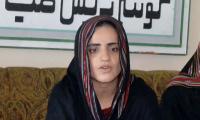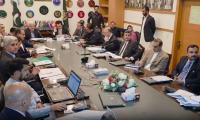Mir Khalil-ur-Rahman’s name is synonymous with continuous struggle. He was a movement, an institution, a legend and a history in himself. His flagship product “Jang” took birth before the birth of Pakistan. It created a history as it became the voice of lakhs of struggling Muslims who wanted to get freedom from British and Hindu Raj and achieve a country where they could live freely. After the creation of Pakistan, Jang started a new journey from the newly established state, and kept on writing history. This year Jang group is celebrating 75 years of Jang in Pakistan with a theme “Jang ka Pakistan Pakistan ka Jang”. The slogan rightly depicts the vision and passion of Mir Sahib, who came to this country along with his newspaper “Jang” where he, like others, wanted to realise his dreams. Jang, an iconic name in the history of Urdu journalism in the subcontinent, lived upto its meaning, the “War.” The paper first waged war in the pre-partition era, against Hindus and British to carve a new country for the Muslims of the subcontinent and after coming to Pakistan, this war was waged against injustice, corruption, monopoly, lawlessness, social and political crimes to ensure freedom of thought and freedom of the press while reaching out to people with truth news.
As he himself once said in his interview, “The dreams and vision with which we created Pakistan couldn’t be realized. I pray from Allah Almighty that the vision behind creating Pakistan and the hopes which people attached to this country are fulfilled and the promises made by the Quaid-i-Azam and other stalwarts of Pakistan movement at the time of independence are fulfilled. The actual vision of Pakistan could not be carried forward by the rulers who ruled the country later on. Rhyming a line from a popular poem, he said, ‘Manzil unhen mili jo shareek-i-safar na they’ (those savoured the fruit of partition, who were not part of the arduous journey”. The main objective of Pakistan movement given by our founding fathers that Pakistan will be for everyone irrespective of cast, creed, colour or ethnicity, where everyone will be free from any fear, disappeared in the dust of time and still remains a farfetched dream.”
Though disappointed with what was happening in Pakistan, Mir Khalil-ur-Rahman, never forgot his own responsibility towards his country/. He played his part through Jang, which was earlier a mouthpiece of the Muslims of the subcontinent and in present day Pakistan is torch bearer of the truth. Besides doing truthful reporting, it promoted Urdu language, built public opinion on critical issues, and catered to the taste of every segment of the society thus becoming the newspaper of masses, a paper which was liked by every member of a family, as it had everything for everyone and generations after generations grew up by reading Jang. While celebrating 75 years of Jang in Pakistan, let’s take a look at the brief history of the emergence and promotion of Urdu journalism over the years in the Indian subcontinent and how Jang played its pivotal role in its growth over the years.
What was started as a means to make communication easier, Urdu emerged as a very strong language in the subcontinent and beyond in the last century and the journey continues. Taking words from Arabic, Turkish, Uzbek, Persian languages, Urdu “began to take shape in what is now Uttar Pradesh, India during the Delhi Sultanate (1206-1527), and continued to develop under the Mughal Empire (1526-1858)”, states Dr Mrinal Chatterjee, in one of his articles.
“One of the leading factors in the progress of Urdu in the undivided India in the 3rd and 4th decade of the 19th century was when East India Company replaced Persian with Urdu and made it co-official, along with English for government institutions and court of law in 1837, to strengthen their foothold in the subcontinent. They also established a college in Calcutta, introduced administrative reforms in the education system, promoted modern education, and built a rail network from Calcutta to Delhi, to ease travelling across India. Sir Syed Ahmed had already initiated a movement for Muslims to learn acquire English education. After Aligarh and Banaras universities, in 1852 more universities were established in Calcutta, Bombay and Madras. Due to these reforms the middle class of people emerged, some of whom joined government jobs, while others supported freedom movement. Printing press had also come and newsprint was also cheaply available,” says Prof Tauseef Ahmed Khan, journalist, writer, scholar, educationist, while describing the history of Urdu journalism in the Indian Subcontinent.
After 1835, many vernacular language newspapers started publishing but Urdu newspapers became more prominent, some gained high circulation as copies of some of these papers were officially subscribed by the British government. Maulvi Muhmmad Baqar published the first Urdu newspaper from Dehli Urdu Akhbar in 1836, the year when Litho type printing had started. With its visual appeal and low cost, it paved way for more newspapers to be published from Delhi, Lahore, Multan, Gujrat, Peshawar, Rawalpindi, Lucknow, Bombay, Aligarh and Madras. Delhi and Lahore were considered the motherlands of Urdu journalism. In Delhi, Urdu press was more critical of the British government. For example, Urdu Akhbar, edited by Syed Hasan, highlighted many civic issues. Jam-i-Jahan-Numa is said to be the first Urdu language newspaper, which started publishing in 1822 in Kolkatta (then Calcutta) by Harihar Dutta. On January 14, 1850, Munshi Harsukh Rai started the weekly Kohinoor, which had a very high (for those times) circulation of 350 copies. In 1858, Manbir Kabiruddin started the Urdu Guide, the first Urdu daily, from Calcutta. In the same year Roznama-e-Punjab was started from Lahore. In 1858, Avadh Akhbar by Munshi Nawal Kishore was the first Urdu newspaper from Lucknow, and continued publication for almost a century.
In the last decades of 19th century advertisement and commercial activity of newspapers also started, giving further boost to journalism, especially Urdu journalism, in terms of attractive lay out, news content and strong vocabulary. By the end of the 19th century, Paisa Akhbar, published from Lahore and edited and founded by Munshi Mahboob Alam, surpassed all other Urdu newspapers in circulation.
War of independence in 1857 gave a severe blow to Urdu journalism as many Urdu newspapers ceased publication. However, after 1857, Urdu journalism developed over the years.
At the beginning of the 20th century, there were only three Urdu dailies, the Paisa Akbhar, the Avadh Akbhar, and the Sulh-i-Kul. This was a period of political uprising in the subcontinent and journalism especially Urdu journalism was taking a lead role in conveying the message of the freedom movement. Father of journalism Maulana Zafar Ali Khan’s Zamindar, a revolutionary paper which started publishing from Lahore in 1903, was the first Urdu newspaper to subscribe to news agencies. Having a high circulation of over 30,000 copies, Zamindar attracted Muslim Youth of Punjab through its nationalistic approach and coverage of news. Maulvi Sanaullah Khan’s Watan, Maulana Muhammad Ali Jauhar’s Naqeeb-e-Hamdard (1912) and Comrade, political periodical the Madina, edited by Hamidul Ansari, awakened political and nationalistic contiguousness of people. Maulana Abul Kalam Azad’s weekly, Al-Hilal designed on the pattern of Egyptian newspapers, built a strong readership due to its content and modern layout. Jawaherlal Nehru founded Qaumi Awaaz in 1945. Anjaam also played a role in the Pakistan movement.
“This was the background in which Jang took birth and grew before and after the partition. It is unarguably the oldest newspaper of Pakistan in continuous publication since its foundation in 1939 and is published from Karachi, Lahore, Rawalpindi, Quetta, Multan and London. It was the passion of Mir Khalil-ur-Rahman that Jang continued its smooth sailing against all odds,” says Prof Tauseef Ahmed Khan. All these big names in Urdu journalism faced jails, punishment, fines and banning of newspapers due to their strong approach towards freedom movement and other political movements in the Indian Sub-continent but they never deterred from speaking the truth. Mir Sahib was also sent behind bar before partition, as he was raising the voice of oppressed Muslims of the subcontinent.
“In the decade of 30s, another change was the role of the editor of a newspaper. Contrary to the early period when the editor used to be an alim, a scholar, a politician, religious scholar, poet, etc, now the era of a professional editor emerged. Editor was a pure journalist now. The first name in this connection was of Majeed Nizami, who took out Nawa-i-waqt. Inqilab was another paper, where people like Chiragh Hasan Hasrat etc were pure journalists with no political role. In Jang, Mir Khalil-ur-Rahman Sahib was a pure journalist, with no political background, yet his newspaper played a pivotal role in the freedom movement. In general Pakistani print media’s main mission was to promulgate the idea of Pakistan, which was seen as the best national option for the Muslim minority in British India and as a form of self-defense against suppression from the Hindu majority.”
After the partition, journalism especially Urdu journalism thrived exponentially in Pakistan with its liberal approach while also continuing its freedom movement ethos with new vision of making the country stable. However, things started changing when the country saw various periods of Martial Laws. But technical advancement in Urdu journalism grew further as content, lay out, design with the adoption of new technology, improved in later years and the change is still going on. Many newspapers and magazines started publishing from various cities of Pakistan. Jamaat-i-Islami published Tasneem and Qasid in the 1950s but stopped publishing later on. Under the same platform, Jasarat was published on March 23, 1970, from Multan and Karachi a couple of months later. It also had its fair share of closures and republications during different periods of dictatorship as well as democracy, but it has maintained its presence in the market uptill now. The Pakistan People’s Party started Musawat from Lahore in 1970, with its edition from Karachi and Faisalabad but later it was banned by the Zia regime.
According to Prof Tauseef Ahmed Khan, Jang has a history of adopting latest technologies of the time and bringing improvement. “It experimented many ideas in terms of improving content, and layout and design of the paper. The entire post partition generation has its fond memories with Jang. The art of calligraphy developed immensely as new fonts of computer replaced the old font styles.
“Aggressive reporting as well as promptness of the news was made possible through the use of technology, like telephone, tele-printers, printers, fax, modem, computers, etc. Internet and digital platforms of social media have entirely transformed the way news and data are gathered, edited, stored, and retrieved. Web News Channels also appeared mostly after 2010. Contrary to the 18th century and 19th century, when people waited for the newspapers, today, availability of news and advertisement on these platforms, are adding new experience to readers. Time has proved that only those papers survived, which maintained balanced reporting and had readers’ friendly content. While keeping in mind all these factors, Jang always attracted its readers through experimenting with novel ideas,” he added.
While going down memory lane, Prof Tauseef says, “In the post partition period, Karachi became the centre of Urdu journalism. Earlier Lahore was the centre, where 20-25 newspapers used to be published in pre-partition days. Urdu became the national language and a new era of Urdu journalism ensued.
In 1947, only four major Muslim-owned newspapers existed in the area now called Pakistan: Pakistan Times, Zamindar, Nawa-i-Waqt, and Civil-Military Gazette (all in Lahore). Civil and Military Gazette stopped its publication soon. A number of Muslim papers and their publishers moved to Pakistan from India, including Dawn, which began publishing daily in Karachi in 1947, the Morning News, and the Urdu-language dailies Jang and Anjam (in Karachi). By the early 2000s, 1,500 newspapers and journals existed in Pakistan.
According to some media reports “in the early 21st century, as in the rest of the world, the number of print outlets in Pakistan declined precipitously, but total circulation increased. From 1994 to 1997, the total number of daily, monthly, and other publications increased from 3,242 to 4,455, but had dropped to just 945 by 2003 with most of the decline occurring in the Punjab Province. However, from 1994 to 2003 total print circulation increased substantially, particularly for dailies (3 million to 6.2 million). And after the low point in 2003 the number of publications grew to 1279 in 2004, to 1997 in 2005, 1467 in 2006, 1820 in 2007, and 1199 in 2008.”
“After the creation of Pakistan the biggest change came when Mian Iftikharuddin established Pakistan Progressive Papers and started publishing Pakistan Times and Imroze on modern lines which matched any western style newspaper, a new trend in Urdu newspaper. Imroze carried world news and also analysis of important news, another new trend. They also had a telephone and the most modern printing machine in their offices, while Zamindar, the biggest and the oldest newspaper distributed in Punjab, KP and Sindh didn’t have those facilities. Its copy down time was 6.00pm as it was printed on litho press. It’s a historical fact that when Jinnah Sahib died, Faiz Sahib got the news of his death from Karachi on telephone. That news was printed only in Imroze in Punjab, while Zamindar and other newspapers missed that news. Besides adopting modern technology, Mian Iftikharuddin who was from Taraqqi Pasand Tehreek, also defined job descriptions of a reporter, news editor, copy holder, sub editor, shift incharge etc and set their pay scales for the first time and also initiated the wage board structure from PPL. That developed the concept of an industry in terms of working conditions as well as pay structure. Jang which was already developing, adopted all these changes, in terms of technology as well as infrastructure and human resource development,” he maintained.
“Two main features which gave Jang an edge over its contemporaries and made it a paper of masses, were: understanding the news value and adoption of new technology. Mir Sahib never stopped printing truthful news. Even during censor and press advice days, during various Martial Laws, Jang managed to print important news through its quality reporting. He never cared for the costs he might have to pay, personally or professionally. Whether it was Ayub Khan, Yahya Khan or Ziaul Haq he printed every news, with the exception of only a few news items which were strictly banned by these governments. Even in such cases sometimes when Jang did violation, it had to pay its price in terms of ban on paper, reduction in newsprint or advertisement,” Tauseef opined.
Once Justice Dr Tanzil ur Rahman, chief justice of Federal Shariat Court, while sharing an anecdote about Mir Khalil-ur-Rahman said, “He was a courageous journalist. During the government of Ayub Khan, he made a headline in his paper in favour of Mohtarma Fatima Jinnah, which quoted Fatima Jinnah’s statement from her speech: “I will shed the last drop of my blood for democracy.” Dictator Ayub Khan called Mir Sahib and made him sit outside his office for five hours and after that he called him in and asked about that headline. Mir Sahib told Ayub Khan in clear terms, “Jang gave a banner headline in your favour. So it is but the ethics of journalism that opposition news are also given prominent coverage.” Justice Dr Tanzil ur Rahman said MKR told him that Gen Zia-ul-Haq offered him minister ship so that he could use all the magazines and newspapers taken out under Mir Sahib’s editorship could be used in his favour. But Mir Sahib didn’t accept that big offer. Such was his commitment to his profession.
During the reign of Zulfiqar Ali Bhutto in 1972, Sindh Assembly passed Sindhi language bill. This resulted language violence in Sindh and many Urdu speaking people were killed in Liaqatabad area of Karachi. On this occasion, prominent poet Rais Amrohvi wrote a long poem. One of its verses read: “Urdu ka janazah hai zara dhoom se nikley” (It’s the funeral procession of Urdu, it should be taken out with great grandeur”. Jang printed it in black border on its front page. It was only the courageous stance, which a person like Mir Sahib could dare to take.
Another factor, Prof Tauseef added, was that “Jang favoured formation of trade union and condition of working journalists was also better in Jang as compared to other newspapers. On the contrary other big newspapers neither allowed trade unions, nor the working conditions of the journalists were good in those newspapers.”
He says the situation still prevails as people working in Jang Media Group are better off than their counterparts in other newspapers.
In terms of marinating quality of journalism, Prof Tauseef says, Mir Sahib always availed the services of good journalists in the market. “Journalists from various schools of thought remained part of Jang group as columnists and editorial writers. Big names like Raees Amrohvi, Syed Mohammad Taqi, Yousuf Siddiqui, Ibrahim Jalees, Inaam Durrani, Ibn-i-Insha, Z A Suleri, and many others always contributed to Jang.” Tauseef opined that till the ’80s, the editorial page of Jang was a little weak as compared to its news content. In the early ’80s when Jang started its publication from Lahore, Irshad Ahmed Haqqani started analysis of various political issues. It was the first of its kind trend in Urdu journalism, started by Jang. Besides Haqqani sahib, progressive journalists like Ahmed Bashir, Zubair Rana, Munno Bhai, joined Jang and liberalized its policy. “It was a future approach because, with the introduction of new satellite TV era and social media, where spread of the news content is extremely robust, other newspapers had to adopt analytical approach later, while Jang was already leading on this path. Later, we saw agenda journalism, campaign-style, hero-driven narratives on history, politics and society, but in its all forms and style, Urdu journalism played a central role in building the opinion of people on any issue.”
Tauseef says, Fakhre Matri was a great journalist of Giujrati language in the ’60s. Considered a doyen of Pakistani journalism, he had modern approach towards journalism. When he started publishing Hurriayet he employed well known journalists of the time. He introduced City page in the paper for the first time. Giving pictorial coverage to the news items, he experimented with modern layout. However, due to their old machinery and limited financial resources, they couldn’t survive. But Jang brought offset press in the ‘60s. It not only increased the size of the newspapers but also expanded news and pictorial coverage, making Jang a frontline newspaper. When Mir Shakil-ur-Rahman took over Jang Lahore in the 80s, he introduced paperless office, publishing the first computerized newspaper.
“I still remember, Majeed Nizami was the president of APNS and CPNE. Since his newspaper had a little conservative approach as they neither printed women news nor their photos, but it was in competition with Jang which gave coverage to everyone. Majeed Nizami demanded from Gen Zia ul Haq to issue Martial Law Regulation to stop circulation war as it was compromising the national security of Pakistan. The move was to stop Jang’s publication by provoking government to ban Jang,” informed Prof Tauseef.
Generally, Urdu newspapers don’t give coverage to stories related to human rights violations, education, health, women, minorities etc. But Mir Khalil-ur-Rahman dedicated special pages for all these social issues. “Even children literature is usually ignored, but Jang’s children magazines, comic series and other stuff made it a family paper.”
The year 2007 brought another change when Justice Movement was started. “It was for the first time that analyses were done about lawyers and judges, making Jang a trendsetter, in analytical journalism. It was robust and aggressive and gave an impression of agenda journalism”, he opined.
Later, “The new initiative of promoting India-Pakistan friendship, through a page ‘Aman Ki Asha’ was again a good move to promote peace in the region. Such an initiative should be taken once again,” he advised.
Tauseef feels that the absence of a professional editor, from newspapers as well as channels, who could run an organization along professional lines and protect his colleagues, is continuously on a decline and has served a great blow to the field of journalism. “Editor means all gate keepers like news editors, shift in charges, section editors, and sub editors, whose responsibility is to keenly check the copy, assess its news value, improve its language and text, and make it newsworthy by adding necessary details. But it is not done now, as many reporters admit that there is hardly anyone who could improvise their copies before printing. Untill the portfolio of the Editor is revived, quality of the news and its language will continue to deteriorate. Using difficult vocabulary or jargons can neither develop the language, nor it can disseminate information which is the main thrust of journalism,” he added.
On a question as to how Urdu language can be promoted, he said, “Urdu has no rivalry with any language of Pakistan, nor we should indulge in this debate, as every language has its own importance. Urdu is a language of love and we should be promoted it the same way by making it easy and simple to understand. Only those languages get appeal of masses which add news words and phrases, but how to use these words in a language is an art which we need to learn. Secondly, the more a language adopts modern technology, the more it grows. In this connection Mir Khalil ur Rahman’s role in introducing Noori Nastaliq, the most modern pre-press production technology in Jang, created history.
Mir Sahib was a legendary figure and an uncrowned king in the field of journalism. It was his newspapers which promoted Urdu language. Due to his clear and unbiased stance, he was respected by people from all schools of thought, as he gave space to the issues of people from all walks of life. Without exaggeration Mir Sahib serves as a spiritual father to new writers. His services for Pakistan and the Urdu language are unmatchable. Whenever the history of Urdu journalism will be written in Pakistan, Mir Khalil-ur-Rahman and his services will be remembered in golden words.
-The writer is a staff member and serving as Editor Supplements and Special Reports of The News International. She can be reached at: sheheronline@gmail.com







